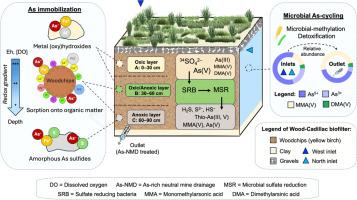Long-term performance of a woodchip-based field-scale biofilter for arsenic removal from neutral mine drainage under cold climate
IF 12.4
1区 环境科学与生态学
Q1 ENGINEERING, ENVIRONMENTAL
引用次数: 0
Abstract
The long-term performance of a woodchip-based field-scale biofilter (50 m x 57 m x 1 m) treating As-rich neutral mine drainage (As-NMD) at the restored Wood-Cadillac mine site (Québec, Canada) was assessed. Operated for over 22 years, the biofilter showed up to 80% As removal efficiency, decreasing As influent concentration from 0.35 to < 0.1 mg/L, and complying with Canadian regulation. Speciation of As revealed depth-dependent redox processes, with As(V) dominating surface layer (0–30 cm), As(III) proportions increased in the middle layer (30–60 cm), while in the deepest layer (60-90 cm), MMA(V) becomes the predominant methylated form. Isotopic analyses () and sulfate concentration profiles suggest localized hotspots of microbial sulfate reduction (MSR) in anoxic layers, associated with higher (> 12.0‰) and lower sulfate concentrations (61 to 10 mg/L). These spots aligned with high relative abundances of sulfate-reducing bacteria, suggesting As immobilization via As–S complexes and FeAsS/AsS precipitates. Microbial analyses showed stable α-diversity of prokaryotic communities, but significant variation among fungal populations. β-diversity differed significantly within the vertical profile of the biofilter, suggesting depth-dependent shifts in the composition of both prokaryotic and fungal communities. Functional taxa involved in S, Fe, and As cycling showed depth-dependent distributions, reflecting stratified redox conditions and biogeochemical processes. These findings highlight the role of coupled microbial and geochemical processes in sustaining As immobilization over decades and support the use of engineered organic biofilters as long-term passive treatment systems for As-NMD.

基于木片的野外规模生物过滤器在寒冷气候下去除中性矿井水中砷的长期性能研究
评估了修复后的Wood-Cadillac矿区(加拿大qu bec)的木屑生物过滤器(50 m x 57 m x 1 m)处理富砷中性矿井水(As-NMD)的长期性能。运行22年以上,生物过滤器的As去除率高达80%,将进水浓度从0.35 mg/L降低到0.1 mg/L,符合加拿大法规。As的形态表现为深度依赖的氧化还原过程,As(V)在表层(0-30 cm)占主导地位,As(III)在中间层(30-60 cm)的比例增加,而在最深层(60-90 cm), MMA(V)成为主要的甲基化形式。同位素分析(δ34SSO42−)和硫酸盐浓度剖面显示,缺氧层中存在微生物硫酸盐还原热点(MSR), δ34SSO42−较高(> 12.0‰),硫酸盐浓度较低(61 ~ 10 mg/L)。这些斑点与硫酸盐还原细菌的相对丰度一致,表明砷通过As - s配合物和FeAsS/AsS沉淀固定。微生物分析表明,原核生物群落α-多样性稳定,但真菌群体间差异显著。β-多样性在生物过滤器的垂直剖面上存在显著差异,表明原核生物和真菌群落的组成发生了深度依赖的变化。参与S、Fe和As循环的功能类群呈现深度依赖分布,反映了分层氧化还原条件和生物地球化学过程。这些发现强调了微生物和地球化学耦合过程在维持砷固定化过程中的作用,并支持了工程有机生物过滤器作为砷- nmd长期被动处理系统的使用。
本文章由计算机程序翻译,如有差异,请以英文原文为准。
求助全文
约1分钟内获得全文
求助全文
来源期刊

Water Research
环境科学-工程:环境
CiteScore
20.80
自引率
9.40%
发文量
1307
审稿时长
38 days
期刊介绍:
Water Research, along with its open access companion journal Water Research X, serves as a platform for publishing original research papers covering various aspects of the science and technology related to the anthropogenic water cycle, water quality, and its management worldwide. The audience targeted by the journal comprises biologists, chemical engineers, chemists, civil engineers, environmental engineers, limnologists, and microbiologists. The scope of the journal include:
•Treatment processes for water and wastewaters (municipal, agricultural, industrial, and on-site treatment), including resource recovery and residuals management;
•Urban hydrology including sewer systems, stormwater management, and green infrastructure;
•Drinking water treatment and distribution;
•Potable and non-potable water reuse;
•Sanitation, public health, and risk assessment;
•Anaerobic digestion, solid and hazardous waste management, including source characterization and the effects and control of leachates and gaseous emissions;
•Contaminants (chemical, microbial, anthropogenic particles such as nanoparticles or microplastics) and related water quality sensing, monitoring, fate, and assessment;
•Anthropogenic impacts on inland, tidal, coastal and urban waters, focusing on surface and ground waters, and point and non-point sources of pollution;
•Environmental restoration, linked to surface water, groundwater and groundwater remediation;
•Analysis of the interfaces between sediments and water, and between water and atmosphere, focusing specifically on anthropogenic impacts;
•Mathematical modelling, systems analysis, machine learning, and beneficial use of big data related to the anthropogenic water cycle;
•Socio-economic, policy, and regulations studies.
 求助内容:
求助内容: 应助结果提醒方式:
应助结果提醒方式:


